
Paradise Cove: They Escaped the Cuckoo's Nest
In his quest to solve the mysterious disappearance of a visionary Hasidic leader, Rabbi Pini Dunner unexpectedly discovered a long-forgotten manuscript, Paradise Cove: They Escaped the Cuckoo’s Nest, leading him to a tale more astonishing than fiction—one of exile, anonymity, reinvention, and redemption.

A raw, uplifting, and humorous account of love and faith.
Kirkus ReviewS
This is a memoir that will touch your heart and soul.
READERS’ FAVORITE
A fascinating biographical and cultural mystery finally solved by meticulous historical detective work
JONATHAN KELLERMAN, New York Times bestselling author of The Museum of Desire
An astonishing story, almost too dramatic and poignant to be real. But it is real, and thanks to Rabbi Pini Dunner we can now read it in the words of the man who lived this astonishing life.
RABBI DAVID WOLPE, bestselling author of Making Loss Matter: Creating Meaning in Difficult Times
A story soaked in the complexities of 20th century Jewish and Israeli history; it is also an inspiring tale of personal redemption
HENRY ABRAMSON, PhD, author of The Sea of Talmud: A Brief and Personal Introduction
ABOUT
Paradise Cove
They Escaped the Cuckoo’s Nest
Paradise Cove: They Escaped the Cuckoo’s Nest is a powerful firsthand account of life inside a Southern California residential house for recovering psychiatric patients—told by an unlikely observer, George T. Nagel, an 80-year-old graduate student volunteering there in the 1970s as part of his psychology fieldwork at California State University, Northridge (CSUN). With clarity, compassion, and humor, Nagel conveys a rare, unfiltered glimpse into the daily struggles and quiet triumphs of those navigating the fragile space between institutionalization and independence—while tracing his own quiet journey toward healing.
But behind this unassuming observer is one of the most extraordinary secrets of the 20th century: George T. Nagel was in fact Rabbi Yechezkel Taub—the Yabloner Rebbe—a visionary Hasidic leader who led his followers from Poland to pre-state Israel in the 1920s before abandoning his faith and disappearing into secular anonymity in Los Angeles for four decades.
Rabbi Pini Dunner, whose passion for reclaiming voices from extraordinary lives long forgotten knows no bounds, discovered the manuscript while researching the Yabloner Rebbe. Rescued from obscurity, with an added preface, epilogue, and meticulous annotations, Dunner provides expert context behind Nagel’s remarkable reflections and restores the lost legacy of a spiritual leader nearly erased from history.
It’s an astonishing story with all the elements of intrigue—a secret identity, an incredible rediscovery, and a bridge between continents, generations, and worlds.
MEET THE AUTHOR
George T. Nagel
George T. Nagel (1895–1986) was born Yechezkel Taub, a scion of the Yabloner Hasidic leadership dynasty in Poland. In the 1920s, he led a large group of his followers to pre- state Israel, founding the pioneering agricultural village of Kfar Hasidim. After a painful falling-out with his community and a profound rupture with his faith, he disappeared from public life and resurfaced in postwar Los Angeles under a new name and identity—George Nagel, a Polish-Jewish immigrant quietly navigating the currents of modern American life.
In the decades that followed, Nagel built a successful career in real estate development. Later in life, after experiencing health setbacks and personal loss, he enrolled at California State University, Northridge (CSUN), earning a BA in psychology. As part of his graduate work, he began volunteering at a nearby residential house for recovering psychiatric patients. Over a period of about two years, and now well into his eighties, Nagel sent “field notes” to his advisor as part of his thesis—108 letters chronicling his time there. These letters—funny, wise, searching, and deeply human—became his manuscript, typeset in 1978, but never published.
Through them, we see a man shaped by extraordinary experiences, still learning, still giving, and still seeking understanding in one of the final chapters of a remarkable life.

MEET THE EDITOR
Rabbi Pini Dunner
Pini Dunner, British-born Senior Rabbi at Beverly Hills Synagogue, leads a Modern-Orthodox congregation that embraces Jews of all backgrounds. Descended from a rabbinic lineage spanning over 1,000 years, and the son of Holocaust survivors, he was raised in London with a deep appreciation for Jewish history and tradition.
A scholar and storyteller fascinated by extraordinary individuals who inhabit the margins of history, Rabbi Dunner seeks out often overlooked and unconventional narratives. A sleuth attracted to the allure of unknown stories, he loves uncovering hidden truths and solving a good mystery. An authority on antiquarian Hebrew books and manuscripts, he advises libraries, academics, collectors, and dealers, and writes widely on Jewish thought, history, politics, and contemporary life.
Author of Mavericks, Mystics & False Messiahs: Episodes from the Margins of Jewish History (2018) and host of the popular video series Rogues, Rascals and Rapscallions, Rabbi Dunner brings to life history’s most curious and controversial Jewish figures. His discovery of George Nagel’s forgotten manuscript, Paradise Cove: They Escaped the Cuckoo’s Nest was the result of his scholarship, insight, and originality. In Paradise Cove, Rabbi Dunner brings Nagel’s remarkable reflections to light for the first time, providing expert context and annotation to a work as surprising as it is profound.

Backstory
1895
Yechezkel Taub is born on October 7, 1895 in Yablona, Poland, a small town near Warsaw that is home to a vibrant Orthodox Jewish community. His father, Rabbi Yaakov Taub, is the “Rebbe” of Yablona, with a following of thousands in Yablona and across Poland.
1920
Rabbi Yaakov Taub dies at the age of 60, leaving the Yablona Hasidic dynasty and following in the hands of his 25-year-old son, Yechezkel, who is now the “Yabloner Rebbe,” leading one of prewar Poland’s most prestigious and wealthy Hasidic sects.

Constanta, Romania, 1925: The Yabloner Rebbe and his followers about to board the ship to pre-state Israel.

Rabbi Taub (left) with his followers in Kfar Hasidim

Rabbi Taub with a group of his follower’s children in Kfar Hasidim
1928
The farming venture struggles from the start. Initially, Yabloner Hasidim in Poland provide enthusiastic support, but the money soon dwindles and eventually disappears. Desperate to keep the dream alive, Rabbi Taub seeks help from secular Zionists and travels to the United States to raise funds. In the end, he strikes a deal with the secular Zionist organization, Keren Kayemet Le’Yisrael (aka Jewish National Fund, or JNF), handing over the land he owns in exchange for their help. The JNF brings in seasoned agricultural pioneers and assumes the community’s debts, ensuring its survival—but at the cost of Rabbi Taub’s original vision.
1938
As conditions for Jews in Poland worsen, Hasidim from Yabłona arrive in Kfar Hasidim eager to claim the plots of land they had purchased years earlier. But Rabbi Taub, having transferred much of the land to the Jewish National Fund in exchange for their support, has nothing left to give his Polish followers—and no way to repay them. Disillusioned and angry, his followers brand him a fraud. The bitter rupture forces Rabbi Taub to leave for the United States, where he hopes to rally American Jewish support and restore both Kfar Hasidim and his shattered reputation.
1945 TO 1970
Rabbi Taub, the Yabloner Rebbe, is no more. His alter-ego, George T. Nagel, becomes a successful real estate developer in postwar Los Angeles.
LATE 1960s
The California economy collapses, and George Nagel’s real estate business goes under. Nearly ruined financially and now in his seventies, Nagel falls seriously ill and is hospitalized. During his recovery, he is visited by a great-nephew from Israel, who urges him to return home. Nagel surprises him with a different plan: “I think I want to go to college and study psychology.”

Rabbi Yaakov Taub (1860-1920)

Rabbi Yechezkel Taub – the "Yabloner Rebbe (1895-1986)
1925
In an unprecedented act of leadership, Rabbi Taub decides to move his entire community to pre-state Israel to create a pioneering Hasidic presence. He raises funds to emigrate, purchase land, and set up an agricultural enclave.
1926
Rabbi Taub and several hundred Hasidic arrive in pre-state Israel, where he purchases land in the hills overlooking the Jezreel Valley near Haifa. Their new settlement becomes known as Kfar Hasidim—“village of the Hasidim.”
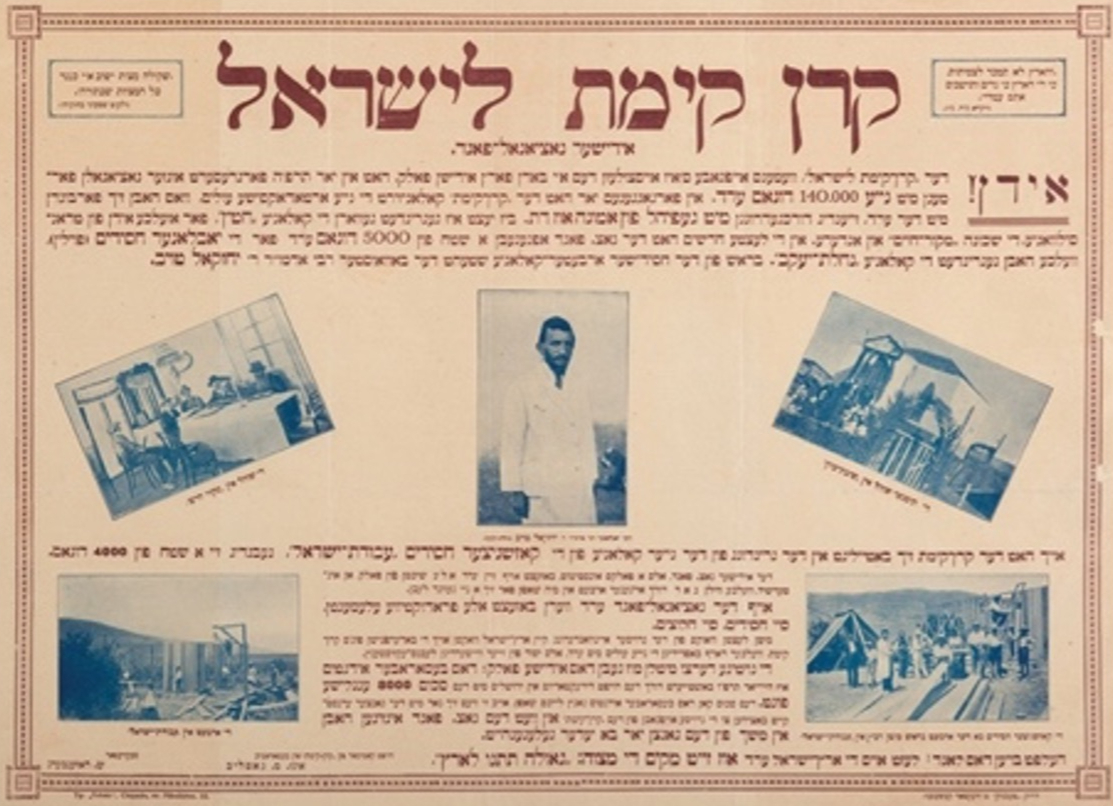
Keren Kayemet Le’Yisrael poster promoting the Kfar Hasidim settlement
1939 TO 1944
Soon after World War II breaks out, Rabbi Taub learns the devastating news that the Nazis have murdered his entire Yabłona Hasidic community in Poland. Only the families who had joined him in Kfar Hasidim remain alive. Believing that these families despise him because of the fights over land and money, and overcome with grief, guilt, and a sense of failure, the once-celebrated Yabloner Rebbe resolves to abandon his past completely.
In the United States, he vanishes into anonymity—discarding his faith and every outward sign of Jewish observance. He removes his yarmulke, shaves his beard, cuts off his sidelocks, stops keeping kosher, and leaves ritual life behind. Reinventing himself, he quietly files immigration papers, takes the oath of allegiance, and becomes a naturalized American citizen under a new name: George Ezekiel Taub Nagel—soon shortened simply to George T. Nagel.

U.S. Declaration of Intention for Naturalization,
February 1941

"George Ezekiel Taub Nagel"
Petition for U.S. Naturalization, December 1944

George T. Nagel: no beard, no sidelocks, no yarmulke.

George Nagel visits one of his residential development construction sites, San Fernando Valley, April 1963.
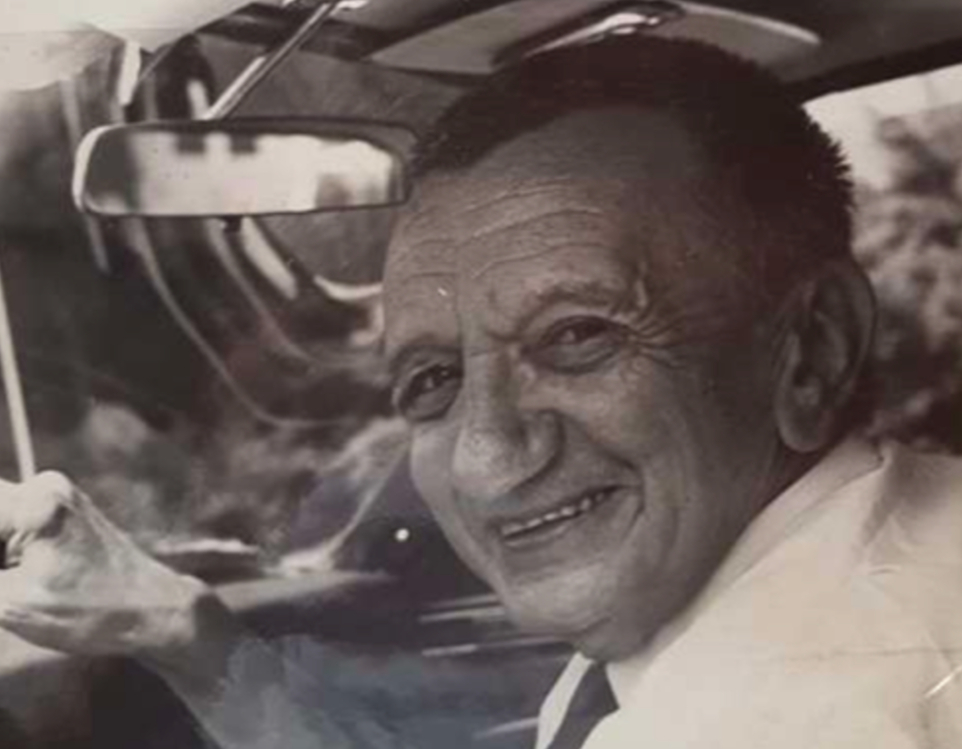
George Nagel driving in Southern California, circa 1960s. He became a very successful businessman.
1971 TO 1975
George Nagel enrolls at California State University, Northridge (CSUN) and even moves into the student dorms. In May 1975, he proudly graduates with a BA in psychology. By this time, he is something of a campus celebrity, with media reports dubbing him “the oldest college student in California.”
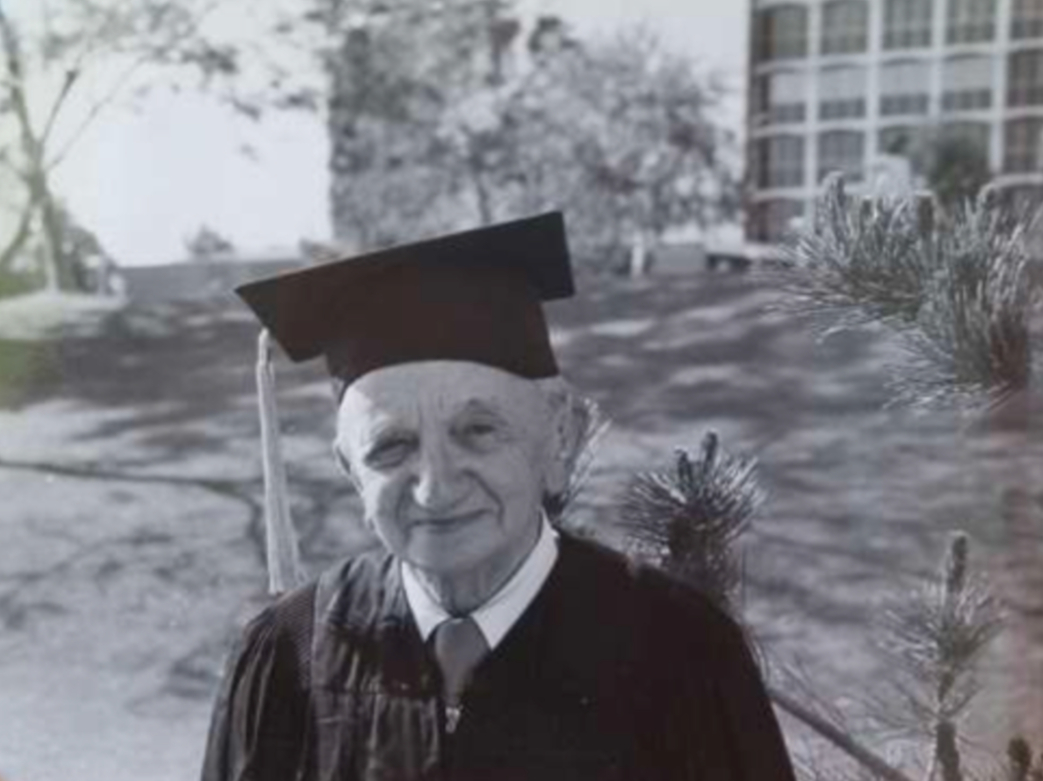
The oldest graduate at California State University, Northridge (CSUN), May 1975.
1976 TO 1978
Nagel stays on at CSUN to pursue a master’s degree.
Instead of enrolling in graduate courses, Nagel arranges with his psychology professor to volunteer at a residential home for recovering psychiatric patients, sending her regular field notes of his experiences.
In just under two years, he produces 108 letters which later become the manuscript for Paradise Cove: They Escaped the Cuckoo’s Nest. Though he never completes his master’s degree, these warm, insightful letters offer a deeply personal window into this unknown period of Nagel’s life.
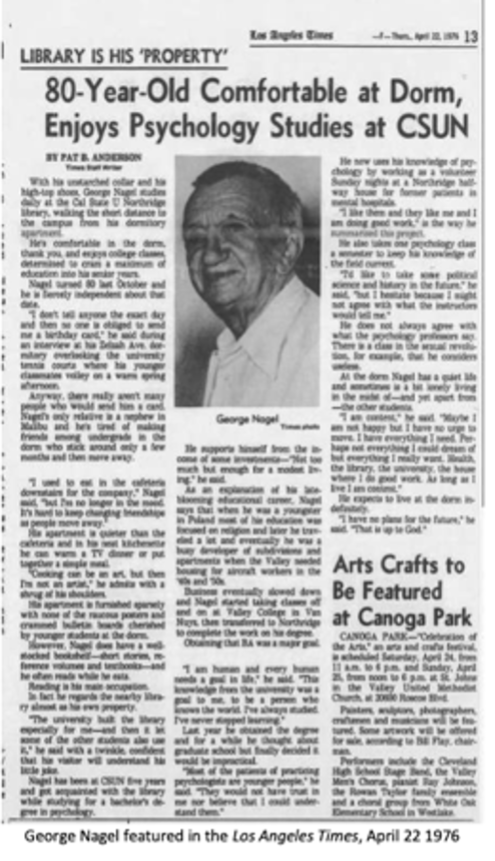
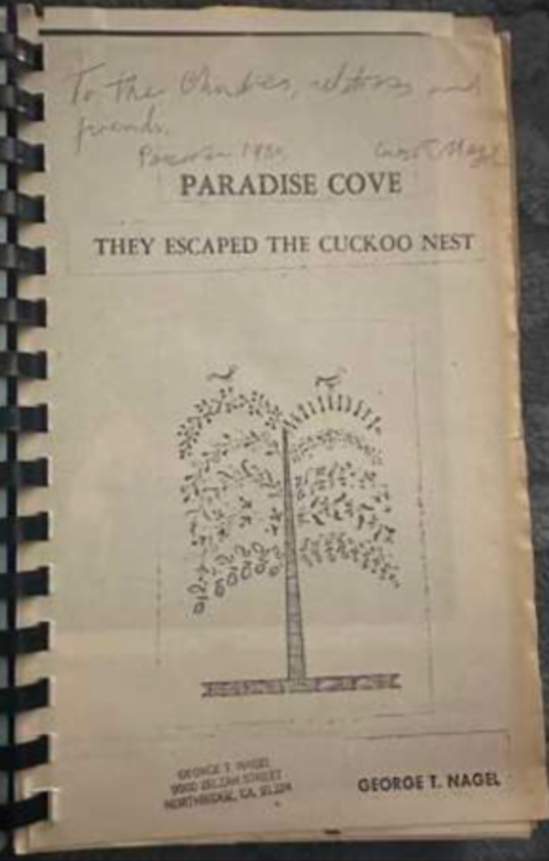
1979 TO 1986
In 1980, George Nagel quietly returns to Kfar Hasidim for a private visit. To his astonishment, hundreds of residents—his original followers, their children, and grandchildren—receive him with open arms. Far from despising him, they thank him for saving their lives by bringing them from Poland, where the rest of the Yabłona community had been murdered by the Nazis.
The following year, now 86, Nagel returns once more—this time to stay. He sheds his assumed identity, reclaims the name Yechezkel Taub, and lets his beard and sidelocks grow back. Once again, he is the Yabloner Rebbe.
After decades of anonymity and exile, the lost Rebbe comes home—redeemed, restored, and embraced by the very community he had believed was lost to him forever.

The Yabloner Rebbe returns to Kfar Hasidim, 1981.

Last known photo of the Yabloner Rebbe, Kfar Hasidim 1986.
1986
Rabbi Taub passes away peacefully on May 22, 1986, at the age of 90. His funeral is simple, attended by the residents of Kfar Hasidim. He is buried among his followers—those who left Poland with him in 1925—who had lived, struggled, and died in Kfar Hasidim. His tombstone is inscribed simply:
Here lies Grand Rabbi Yechezkel Taub, the ‘Rebbe of Yablona,’
Son of Grand Rabbi Yaakov Taub.
Last scion of the dynasty that began with Grand Rabbi Yechezkel of Kuzmir,
Disciple of the ‘Seer of Lublin.’
In 5685 he led his Hasidim up to Eretz Yisrael,
Redeeming the lands of Harbaj, Harchieh, and Sheikh Abreik.
Founder of Nahalat Yaakov, later known as Kfar Hasidim.

Rabbi Pini Dunner, whose research resulted in the Yabloner Rebbe’s full life story coming to light, at his grave in Kfar Hasidim, 2019.
BACKSTORY
1895
Yechezkel Taub is born on October 7, 1895 in Yablona, Poland, a small town near Warsaw that is home to a vibrant Orthodox Jewish community. His father, Rabbi Yaakov Taub, is the “Rebbe” of Yablona, with a following of thousands in Yablona and across Poland.
1920
Rabbi Yaakov Taub dies at the age of 60, leaving the Yablona Hasidic dynasty and following in the hands of his 25-year-old son, Yechezkel, who is now the “Yabloner Rebbe,” leading one of prewar Poland’s most prestigious and wealthy Hasidic sects.
1928
The farming venture struggles from the start. Initially, Yabloner Hasidim in Poland provide enthusiastic support, but the money soon dwindles and eventually disappears. Desperate to keep the dream alive, Rabbi Taub seeks help from secular Zionists and travels to the United States to raise funds. In the end, he strikes a deal with the secular Zionist organization, Keren Kayemet Le’Yisrael (aka Jewish National Fund, or JNF), handing over the land he owns in exchange for their help. The JNF brings in seasoned agricultural pioneers and assumes the community’s debts, ensuring its survival—but at the cost of Rabbi Taub’s original vision.
1938
As conditions for Jews in Poland worsen, Hasidim from Yabłona arrive in Kfar Hasidim eager to claim the plots of land they had purchased years earlier. But Rabbi Taub, having transferred much of the land to the Jewish National Fund in exchange for their support, has nothing left to give his Polish followers—and no way to repay them. Disillusioned and angry, his followers brand him a fraud. The bitter rupture forces Rabbi Taub to leave for the United States, where he hopes to rally American Jewish support and restore both Kfar Hasidim and his shattered reputation.
1945 TO 1970
Rabbi Taub, the Yabloner Rebbe, is no more. His alter-ego, George T. Nagel, becomes a successful real estate developer in postwar Los Angeles.
LATE 1960's
The California economy collapses, and George Nagel’s real estate business goes under. Nearly ruined financially and now in his seventies, Nagel falls seriously ill and is hospitalized. During his recovery, he is visited by a great-nephew from Israel, who urges him to return home. Nagel surprises him with a different plan: “I think I want to go to college and study psychology.”

Rabbi Yaakov Taub; (1860-1920)

Rabbi Yechezkel Taub – the "Yabloner Rebbe (1895-1986)
1925
In an unprecedented act of leadership, Rabbi Taub decides to move his entire community to pre-state Israel to create a pioneering Hasidic presence. He raises funds to emigrate, purchase land, and set up an agricultural enclave.
1926
Rabbi Taub and several hundred Hasidic arrive in pre-state Israel, where he purchases land in the hills overlooking the Jezreel Valley near Haifa. Their new settlement becomes known as Kfar Hasidim—“village of the Hasidim.”
1939 TO 1944
Soon after World War II breaks out, Rabbi Taub learns the devastating news that the Nazis have murdered his entire Yabłona Hasidic community in Poland. Only the families who had joined him in Kfar Hasidim remain alive. Believing that these families despise him because of the fights over land and money, and overcome with grief, guilt, and a sense of failure, the once-celebrated Yabloner Rebbe resolves to abandon his past completely.
In the United States, he vanishes into anonymity—discarding his faith and every outward sign of Jewish observance. He removes his yarmulke, shaves his beard, cuts off his sidelocks, stops keeping kosher, and leaves ritual life behind. Reinventing himself, he quietly files immigration papers, takes the oath of allegiance, and becomes a naturalized American citizen under a new name: George Ezekiel Taub Nagel—soon shortened simply to George T. Nagel.

George T. Nagel: no beard, no sidelocks, no yarmulke.

George Nagel visits one of his residential development construction sites, San Fernando Valley, April 1963.

George Nagel driving in Southern California, circa 1960s. He became a very successful businessman.
1971 TO 1975
George Nagel enrolls at California State University, Northridge (CSUN) and even moves into the student dorms. In May 1975, he proudly graduates with a BA in psychology. By this time, he is something of a campus celebrity, with media reports dubbing him “the oldest college student in California.”

The oldest graduate at California State University, Northridge (CSUN), May 1975.
1976 TO 1978
Nagel stays on at CSUN to pursue a master’s degree.
Instead of enrolling in graduate courses, Nagel arranges with his psychology professor to volunteer at a residential home for recovering psychiatric patients, sending her regular field notes of his experiences.
In just under two years, he produces 108 letters which later become the manuscript for Paradise Cove: They Escaped the Cuckoo’s Nest. Though he never completes his master’s degree, these warm, insightful letters offer a deeply personal window into this unknown period of Nagel’s life.
1979 TO 1986
In 1980, George Nagel quietly returns to Kfar Hasidim for a private visit. To his astonishment, hundreds of residents—his original followers, their children, and grandchildren—receive him with open arms. Far from despising him, they thank him for saving their lives by bringing them from Poland, where the rest of the Yabłona community had been murdered by the Nazis.
The following year, now 86, Nagel returns once more—this time to stay. He sheds his assumed identity, reclaims the name Yechezkel Taub, and lets his beard and sidelocks grow back. Once again, he is the Yabloner Rebbe.
After decades of anonymity and exile, the lost Rebbe comes home—redeemed, restored, and embraced by the very community he had believed was lost to him forever.
1986
Rabbi Taub passes away peacefully on May 22, 1986, at the age of 90. His funeral is simple, attended by the residents of Kfar Hasidim. He is buried among his followers—those who left Poland with him in 1925—who had lived, struggled, and died in Kfar Hasidim. His tombstone is inscribed simply:
Here lies Grand Rabbi Yechezkel Taub, the ‘Rebbe of Yablona,’
Son of Grand Rabbi Yaakov Taub.
Last scion of the dynasty that began with Grand Rabbi Yechezkel of Kuzmir,
Disciple of the ‘Seer of Lublin.’
In 5685 he led his Hasidim up to Eretz Yisrael,
Redeeming the lands of Harbaj, Harchieh, and Sheikh Abreik.
Founder of Nahalat Yaakov, later known as Kfar Hasidim.

Rabbi Pini Dunner, whose research resulted in the Yabloner Rebbe’s full life story coming to light, at his grave in Kfar Hasidim, 2019.

Rabbi Taub (left) with his followers in Kfar Hasidim

Rabbi Taub with a group of his follower’s children in Kfar Hasidim

Constanta, Romania, 1925: The Yabloner Rebbe and his followers about to board the ship to pre-state Israel.

Keren Kayemet Le’Yisrael poster promoting the Kfar Hasidim settlement

U.S. Declaration of Intention for Naturalization,
February 1941

"George Ezekiel Taub Nagel"
Petition for U.S. Naturalization, December 1944

The Yabloner Rebbe returns to Kfar Hasidim, 1981.

Last known photo of the Yabloner Rebbe, Kfar Hasidim 1986.


SPEAKING & APPEARANCES
Rabbi Pini Dunner–Renowned Speaker, Scholar, and Storyteller
Rabbi Pini Dunner is an internationally recognized speaker, distinguished historian, and captivating storyteller. Frequently invited to address audiences at conferences, universities, cultural forums, and private institutions across the United States and around the globe, Rabbi Dunner is known for his dynamic style, deep scholarship, and an innate ability to bring complex ideas to life with clarity, warmth, and humor.
Admired for his expertise in Jewish history, philosophy, and sacred texts, with an insightful understanding of today’s cultural, political, and ethical challenges, Rabbi Dunner uniquely bridges the ancient and the contemporary. A thought leader who connects historical lessons to modern dilemmas, his talks cover a wide range of topics including academia, media, business, and the wisdom of Judaism.
A passionate collector of rare books, manuscripts, and historical artifacts, Rabbi Dunner is also a respected authority on antiquarian Hebrew texts. Libraries, academics, and private collectors often seek his guidance, and his groundbreaking discoveries frequently inform his lectures and writings. His thought-provoking articles on history, philosophy, politics, and rabbinic texts appear regularly in newspapers and journals, making him a trusted voice on matters of faith and culture.
Whether speaking to scholars, business leaders, or interfaith audiences, Rabbi Dunner’s dynamic presentations leave listeners inspired, informed, and eager to explore the deeper questions that shape our lives and communities.
"Rabbi Dunner is an inspirational speaker who has the ability to weave history, theology, politics, and contemporary events into a fascinating and compelling oratorical display that lights up convention halls and public gatherings."
THE BASH

PRESS

NEWS SOURCE
DATE
Article / Video Title
Add paragraph text. Click “Edit Text” to update the font, size and more. To change and reuse text themes, go to Site Styles.

NEWS SOURCE
DATE
Article / Video Title
Add paragraph text. Click “Edit Text” to update the font, size and more. To change and reuse text themes, go to Site Styles.

NEWS SOURCE
DATE
Article / Video Title
Add paragraph text. Click “Edit Text” to update the font, size and more. To change and reuse text themes, go to Site Styles.





